When you use WordPress you’re given the choice when publishing between doing it as a ‘post’ or as a ‘page‘. Posts go up on your blog while ‘pages’ are static pages that you can publish without it having to go up on your blog.
There’s a lot of reasons why you might choose a post over a page or a page over a post (that’s for another post) - but today I thought I’d highlight a few ‘pages’ that I have here on ProBlogger as examples of pages that bloggers might want to develop to promote their blog to different groups of people. Some are more essential in my mind than others but all have been helpful in the development of my own blogs.
 1. About Page - perhaps one of the most common uses of the ‘page’ function on WP is the good old ‘about page’. Having an about page is essential in my mind as it gives new readers to your blog a snapshot of who you are and why they should subscribe to your blog. This is the page that I go to every time I hit a new blog - if they don’t have one it decreases my chances of subscribing significantly. Read more on adding an about page to your blog.
1. About Page - perhaps one of the most common uses of the ‘page’ function on WP is the good old ‘about page’. Having an about page is essential in my mind as it gives new readers to your blog a snapshot of who you are and why they should subscribe to your blog. This is the page that I go to every time I hit a new blog - if they don’t have one it decreases my chances of subscribing significantly. Read more on adding an about page to your blog.
 2. Contact Page - I’m amazed how many bloggers don’t have any way of contacting them on their blog. While I understand the temptation not to have one you could be missing out of wonderful opportunities by not giving readers, potential partners, press, other bloggers a way of contacting you. Read more on Why your blog’s readers should be able to contact you.
2. Contact Page - I’m amazed how many bloggers don’t have any way of contacting them on their blog. While I understand the temptation not to have one you could be missing out of wonderful opportunities by not giving readers, potential partners, press, other bloggers a way of contacting you. Read more on Why your blog’s readers should be able to contact you.
 3. Press Page - I don’t promote this page heavily (although do mention it on my ‘About Page‘) but use it more when interacting with journalists and mainstream media outlets. The way I use it is to show journalists what others have written about me. I find that in providing a list of previous articles in mainstream media you gain a little credibility and give journalists a head start in finding an angle to pursue for their own potential articles about you. It’s also handy to be able to provide this page to anyone else that you’re attempting to build credibility with that may not be that ‘new media savvy’. It’s amazing how a mention in mainstream media will open doors for some.
3. Press Page - I don’t promote this page heavily (although do mention it on my ‘About Page‘) but use it more when interacting with journalists and mainstream media outlets. The way I use it is to show journalists what others have written about me. I find that in providing a list of previous articles in mainstream media you gain a little credibility and give journalists a head start in finding an angle to pursue for their own potential articles about you. It’s also handy to be able to provide this page to anyone else that you’re attempting to build credibility with that may not be that ‘new media savvy’. It’s amazing how a mention in mainstream media will open doors for some.
 4. Disclaimer Page - I need to update this page but for the interests of transparency have it linked to on every page on my blog to show readers what I get out of this blog - ie that I make money from it and use affiliate programs. I also use this page to dispel some of the myths and untrue assumptions that people have about me and this blog by sharing some of the ‘costs’ of this blog. I find that this balanced ‘disclaimer’ works quite well.
4. Disclaimer Page - I need to update this page but for the interests of transparency have it linked to on every page on my blog to show readers what I get out of this blog - ie that I make money from it and use affiliate programs. I also use this page to dispel some of the myths and untrue assumptions that people have about me and this blog by sharing some of the ‘costs’ of this blog. I find that this balanced ‘disclaimer’ works quite well.
 5. FAQ Page - this page was written with a very selfish motive - to cut down my workload. I get asked a lot of question, many of them repeatedly. As an attempt to answer some of these frequently asked questions I put together some answers for them. I still get asked the questions but being able to point to this page helps. I also have it linked to prominently from my Contact Page.
5. FAQ Page - this page was written with a very selfish motive - to cut down my workload. I get asked a lot of question, many of them repeatedly. As an attempt to answer some of these frequently asked questions I put together some answers for them. I still get asked the questions but being able to point to this page helps. I also have it linked to prominently from my Contact Page.
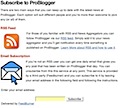 6. Subscribe Page - having a page dedicated to how people can subscribe to your blog can be very useful. I don’t link to this from my sidebar any more (like I do at DPS) but do link to it from within posts at times. I find that having a page like this can be useful as some readers don’t understand the idea of RSS or can be worried about issues of privacy or what it means to ’subscribe’. Sometimes having a page dedicated to walking people through the process can pay off.
6. Subscribe Page - having a page dedicated to how people can subscribe to your blog can be very useful. I don’t link to this from my sidebar any more (like I do at DPS) but do link to it from within posts at times. I find that having a page like this can be useful as some readers don’t understand the idea of RSS or can be worried about issues of privacy or what it means to ’subscribe’. Sometimes having a page dedicated to walking people through the process can pay off.
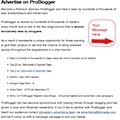 7. Advertise with Us Page - looking to sell advertising on your blog? An ‘Advertise’ page is an important part of attracting new advertisers and a well written one can cut down a lot of work for you as it’ll help to filter out people by giving them information that helps them to know if your site is right for them. Further Reading: Finding Advertisers for Your Blog.
7. Advertise with Us Page - looking to sell advertising on your blog? An ‘Advertise’ page is an important part of attracting new advertisers and a well written one can cut down a lot of work for you as it’ll help to filter out people by giving them information that helps them to know if your site is right for them. Further Reading: Finding Advertisers for Your Blog.
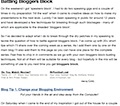 8. Series Page - Compilation - I’ve used ‘pages’ in two ways when it comes to series of posts. The first way is to put together a compilation page of all of the posts in a series. I don’t do this that regularly but in the example linked to put together the content from all 25 posts on my series on Battling Bloggers Block. I found that some readers really appreciated having the series all in the one place.
8. Series Page - Compilation - I’ve used ‘pages’ in two ways when it comes to series of posts. The first way is to put together a compilation page of all of the posts in a series. I don’t do this that regularly but in the example linked to put together the content from all 25 posts on my series on Battling Bloggers Block. I found that some readers really appreciated having the series all in the one place.
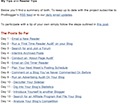 9. Series Page - Central Page - the other approach to managing a series of posts with a ‘page’ is to use one as a ‘central links page’ that you update with a link to each post in your series over time. This is what I did in my 31 Days to Building a Better Blog Series last August. The beauty of this approach over the ‘compilation page’ is that it can drive a lot more page views as readers are ’sneezed’ in multiple directions into your blog. It’s also good because it allows readers to be more selective about which posts in a series they want to read rather than reading the full thing.
9. Series Page - Central Page - the other approach to managing a series of posts with a ‘page’ is to use one as a ‘central links page’ that you update with a link to each post in your series over time. This is what I did in my 31 Days to Building a Better Blog Series last August. The beauty of this approach over the ‘compilation page’ is that it can drive a lot more page views as readers are ’sneezed’ in multiple directions into your blog. It’s also good because it allows readers to be more selective about which posts in a series they want to read rather than reading the full thing.
 10. Affiliate Pre-Sell Pages - having a dedicated page for an affiliate program that you’re running can be a very smart move. If you refer to a product that you’re promoting regularly in your posts - rather than linking to the affiliate program link to a ‘pre-sell’ page on your own blog. This allows you to ‘pre-sell’ the product more with a personal message. This is what I do on my AdSense page here at ProBlogger. This doesn’t work for every affiliate program but I find with AdSense that it works well as their landing page can be a little off putting to new potential users of it. It also gives me a little more flexibility with how I mention AdSense in my posts as their Referrals program doesn’t allow html linking. Further Reading: 5 Tips for Improving AdSense Referral Earnings.
10. Affiliate Pre-Sell Pages - having a dedicated page for an affiliate program that you’re running can be a very smart move. If you refer to a product that you’re promoting regularly in your posts - rather than linking to the affiliate program link to a ‘pre-sell’ page on your own blog. This allows you to ‘pre-sell’ the product more with a personal message. This is what I do on my AdSense page here at ProBlogger. This doesn’t work for every affiliate program but I find with AdSense that it works well as their landing page can be a little off putting to new potential users of it. It also gives me a little more flexibility with how I mention AdSense in my posts as their Referrals program doesn’t allow html linking. Further Reading: 5 Tips for Improving AdSense Referral Earnings.
 11. Services Pages - If you offer services to readers then develop a dedicated sales page for yourself and link to it prominently on your blog. The example here is my Consulting page - a page I used to point to regularly. These days I don’t offer these services any more (due to workload) so have not promoted it for a while. I find that when you have a dedicated page to selling your services you can sell yourself much more expansively than just a quick mention elsewhere on your blog.
11. Services Pages - If you offer services to readers then develop a dedicated sales page for yourself and link to it prominently on your blog. The example here is my Consulting page - a page I used to point to regularly. These days I don’t offer these services any more (due to workload) so have not promoted it for a while. I find that when you have a dedicated page to selling your services you can sell yourself much more expansively than just a quick mention elsewhere on your blog.
 12. Key Information Pages - Do you have information that you’re constantly providing to people over and over again (whether in blog posts, via email or in other ways)? Make a page about it and keep the link handy. That’s what I did with my b5media page and have found it to help me cut down my workload in answering questions about the network. I also link to it in my navigational bar here on ProBlogger and it’s lead to some great opportunities. You could do this with any business or product that you’re associated with.
12. Key Information Pages - Do you have information that you’re constantly providing to people over and over again (whether in blog posts, via email or in other ways)? Make a page about it and keep the link handy. That’s what I did with my b5media page and have found it to help me cut down my workload in answering questions about the network. I also link to it in my navigational bar here on ProBlogger and it’s lead to some great opportunities. You could do this with any business or product that you’re associated with.
 13. Landing Pages - this page is an example of one over at DPS that I used last year as a landing page for an ad campaign that I ran. If you do choose to run an ad campaign to promote your blog then it’s much wiser to link your ads to a dedicated landing page than the front page of your blog. Read more on Advertising Your Blog and on Landing Pages.
13. Landing Pages - this page is an example of one over at DPS that I used last year as a landing page for an ad campaign that I ran. If you do choose to run an ad campaign to promote your blog then it’s much wiser to link your ads to a dedicated landing page than the front page of your blog. Read more on Advertising Your Blog and on Landing Pages.
 14. Sneeze Pages - one great way to propel people deep within your blog is to develop a Sneeze Page or a ‘Best of’ page that highlights some of the better articles on your blog around a particular theme. Put links to these pages on your sidebar or refer to them in posts and you’ll see your page impressions per visit statistics go up.
14. Sneeze Pages - one great way to propel people deep within your blog is to develop a Sneeze Page or a ‘Best of’ page that highlights some of the better articles on your blog around a particular theme. Put links to these pages on your sidebar or refer to them in posts and you’ll see your page impressions per visit statistics go up.
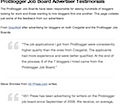 15. Testimonial Pages - if you’re selling something (even if it’s yourself) to have some sort of a testimonial page can be very worthwhile. People base buying decisions increasingly upon the opinions of others - so capture some of these opinions and present them.
15. Testimonial Pages - if you’re selling something (even if it’s yourself) to have some sort of a testimonial page can be very worthwhile. People base buying decisions increasingly upon the opinions of others - so capture some of these opinions and present them.
 16. Event Specific Pages - speaking at an event? Create a ‘page’ specifically for those at it and mention that you’ve done so in your presentation. This way you can tailor a specific message to those visitors, their needs, your presentation and ’sell’ something to them (whether it be subscribing to your blog, buying a product, selling your services or getting them to read certain pages on your blog. The example I’ve given is from a conference I did this time last year. I also used to have a section on that page selling a product that I mentioned in the presentation and it converted quite well.
16. Event Specific Pages - speaking at an event? Create a ‘page’ specifically for those at it and mention that you’ve done so in your presentation. This way you can tailor a specific message to those visitors, their needs, your presentation and ’sell’ something to them (whether it be subscribing to your blog, buying a product, selling your services or getting them to read certain pages on your blog. The example I’ve given is from a conference I did this time last year. I also used to have a section on that page selling a product that I mentioned in the presentation and it converted quite well.
 17. 404 Page - when people arrive on your blog to a page that has been deleted, follow a dead link etc and end up on a default error page on your blog you’ve got a wasted opportunity on your hands. Customize your error pages to help readers find what they’re looking for or at least find something else that might interest them. Further Reading: How to Create a Custom 404 Error Page for Your Blog.
17. 404 Page - when people arrive on your blog to a page that has been deleted, follow a dead link etc and end up on a default error page on your blog you’ve got a wasted opportunity on your hands. Customize your error pages to help readers find what they’re looking for or at least find something else that might interest them. Further Reading: How to Create a Custom 404 Error Page for Your Blog.
 18. Special Projects - Last year I participated in a charity event called (Movember). Rather than letting this event completely take over my blog for the month I created a dedicated page for the event that those who were interested in could follow my updates on.
18. Special Projects - Last year I participated in a charity event called (Movember). Rather than letting this event completely take over my blog for the month I created a dedicated page for the event that those who were interested in could follow my updates on.
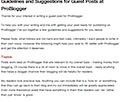 19. Guest Blogger Page - I’ve never spoken publicly about this page on ProBlogger before but it’s a page that I provide to guest bloggers of ProBlogger with some guidelines on how to write for this blog. I’ve done the same thing for DPS and have found that it’s been very useful. I get more posts that are written in a format that I can use and it’s cut down a lot of work for me.
19. Guest Blogger Page - I’ve never spoken publicly about this page on ProBlogger before but it’s a page that I provide to guest bloggers of ProBlogger with some guidelines on how to write for this blog. I’ve done the same thing for DPS and have found that it’s been very useful. I get more posts that are written in a format that I can use and it’s cut down a lot of work for me.
 20. Archives Page - there are numerous ways that you can present that archives of your blog. It becomes more challenging the larger your blog grows to be able to direct people back to your best previous work and a dedicated page can be helpful in that process rather than just presenting a list of categories or dates on your site bar. What I’ve attempted to do with mine is to provide a page with dated archives but also categories with some suggested starting points.
20. Archives Page - there are numerous ways that you can present that archives of your blog. It becomes more challenging the larger your blog grows to be able to direct people back to your best previous work and a dedicated page can be helpful in that process rather than just presenting a list of categories or dates on your site bar. What I’ve attempted to do with mine is to provide a page with dated archives but also categories with some suggested starting points.
Some of the above ‘pages’ can of course be created from ‘posts’ on your blog (and there might be some good reasons for doing so) however my preference is to make them ‘pages’. In most cases this is because I prefer these pages to not be date specific. The way I have my links set up here at ProBlogger posts have dates showing and in the link structure - but pages don’t. In many of the above examples I also didn’t want to page to show up in my blog’s RSS feed or categories - but preferred them to be standalone pages.
What page types would you add to the above list?
Update: Some great suggestions in comments so far. I agree that a privacy page is a good one, as is a comments policy (I have one of these but wrote it as a post - I think it’d be more appropriate as a page though). Another one that I should have included is a ‘resource’ page - a page that lists recommended resources, books, courses etc. Lastly - I should have included a ‘blog roll’ or ‘links’ page. Thanks for everyone’s suggestions - keep them coming.
Share This

 1. About Page
1. About Page 2. Contact Page
2. Contact Page 3. Press Page
3. Press Page 4. Disclaimer Page
4. Disclaimer Page 5. FAQ Page
5. FAQ Page 6. Subscribe Page
6. Subscribe Page 7. Advertise with Us Page
7. Advertise with Us Page 8. Series Page - Compilation
8. Series Page - Compilation 9. Series Page - Central Page
9. Series Page - Central Page 10. Affiliate Pre-Sell Pages
10. Affiliate Pre-Sell Pages 11. Services Pages
11. Services Pages 12. Key Information Pages
12. Key Information Pages 13. Landing Pages
13. Landing Pages 14. Sneeze Pages
14. Sneeze Pages 15. Testimonial Pages
15. Testimonial Pages 16. Event Specific Pages
16. Event Specific Pages 17. 404 Page
17. 404 Page 18. Special Projects
18. Special Projects 19. Guest Blogger Page
19. Guest Blogger Page 20. Archives Page
20. Archives Page